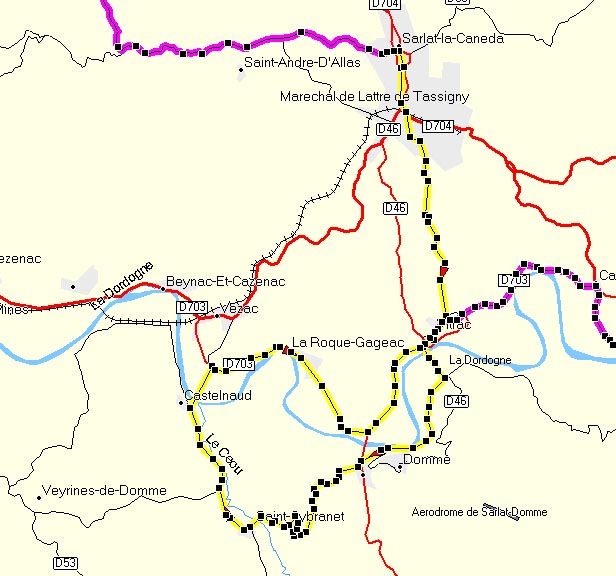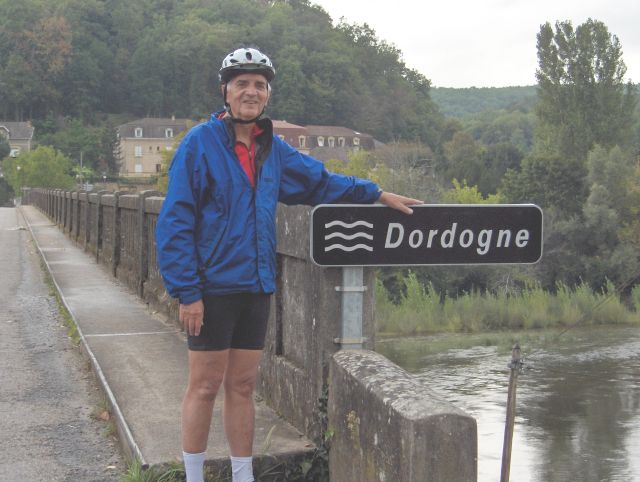
Cycling Southwest France - Biking the Dordogne
Day 5 - Sarlat to Vitrac - 25.7 miles

When we first laid out the trip, we only had six days of cycling. It was hard to find a seventh, and finally we settled by adding a loop from Sarlat, through Vitrac and around a circle to the south back to Vitrac. This was a route recommended in Cycling France.
As usual, it was raining as we ate breakfast. It had diminished to a drizzle as we got our bikes out of storage at the hotel, and by the time we were loaded the rain had stopped. Just as we had come to expect. It was Saturday in Sarlat -- the market day. The town was jammed packed. We awkwardly pushed our bikes through the old town. It was almost impossible to move in the throngs of people and all the market stands.

Saturday morning, market day, in Sarlat
Finally we reached the road, which was packed with traffic of people coming in and out of the market. I sometimes classify biking into the categories safe, awkward, or dangerous. I would guess that at least 90% of this trip would be classified as safe. "Awkward" is when you have to negotiate an intersection, waiting for a break in traffic, or when you're biking along with cars in a slow-moving mass. "Dangerous" is when you have to bike in fast, heavy traffic, and there's no room on the road. Leaving Sarlat was dangerous.
Fortunately, a little ways out of town we turned off the main highway up a little-used road. It was a big hill, but nevertheless I was glad to see it. The cars were gone. At the top of the hill we biked for about five miles on top of a ridge. It was farm country.

We pass pretty farm country along a ridge
Our destination, Vitrac, was only about seven miles from our starting point, Sarlat. We intended to check into our hotel there, leave our panniers, and then bike a loop around and back to the hotel. So after only a few miles of easy biking along the ridge we reached Vitrac. It was a very small town located on top of a steep hill. The river was below. We didn't see any hotels. We stopped and consulted. We didn't want to bike down the steep hill and then discover that our hotel was back at the top. But there was no one to ask, and there just didn't seem to any hotels where we were, so with some hesitance we coasted down the hill. After a wrong turn at the bottom we retreated and found our hotel. The hotel people had our rooms ready and were used to bikers leaving their panniers there. Maybe it's the influence of Cycling France, which recommends this.
We were looking forward to biking without the load of our panniers, so it was a relief to rid ourselves of these encumbrances at our hotel rooms. We set out again, and almost immediately crossed the Dordogne. It was a river that had become familiar in the early days of our trip, but one that we had left for the last several days. It was like rejoining an old friend.

Once again we're back to the Dordogne
We could see the town of Domme high on a hill above us. It would be a detour off our route, but it was a town that was recommended by Michelin as a tourist attraction. Len wanted to bike up, while I was reluctant. However, the rest of the day was relatively devoid of tourist attractions, and this seemed worth the climb.

The town of Domme on a cliff above us
We started the long climb to Domme. Both Len and I agreed later that we didn't notice the difference in biking without the loads of our panniers. We had expected the bikes to feel light, but it wasn't apparent. The panniers weighed about 20 pounds, or perhaps 10% of the total weight of bike and rider.
As usual, Len got quite far ahead of me on the climb. I was going slowly and steadily. I think he attacks the hills. Whatever; he gets up them a lot faster than I do. Eventually I got to an intersection in the road. There was a sign at the intersection saying that parking for Domme was to the left. I went left and saw a big parking lot with tour buses. I thought I might see Len there waiting for me, but he wasn't. Then I assumed that the parking was for cars, which were forbidden in the town of Domme. I could bike on directly to the town. I was then at an elevation of 615 feet. I biked onwards and upwards.
I saw no sign of a town as I biked ever upwards. Presently, I reached what appeared to be the top of the hill. I was at an elevation of 930 feet. There was an airport there and farm country that seemed to extend to infinity. Where was Domme? I started to worry.
I took my walkie-talkie out of my handlebar and pressed the "call" button. Nothing.
I must have done something wrong. I started back down the hill, hoping that I wouldn't have to climb back again. After a half mile or so I tried the walkie-talkie again. This time Len answered. "Where are you?" I asked -- an obvious and stupid question. Of course, he was in Domme, but where was Domme, and where was I? He described a turn in the road that made no sense to me. I told him to hang on while I coasted down the hill some more.
I reset my GPS to show high detail (the level at which very small towns like Domme would be labelled). Now I could see Domme on the GPS. It was considerably down the hill.
Around a bend I could suddenly see Domme below me. How had I missed it? It was obvious in this direction, but hidden in the upward direction.
Len was waiting for me at the city gate of Domme. The walkie-talkies had proved their worth in this single use.

Len waits at the gate of Domme
Domme was a small enclave with a religious history, perched on a cliff overlooking a panoramic view of the Dordogne countryside. We walked through the small town. It had the usual stores selling food stuffs made of duck-this and duck-that. We saw these stores everywhere. For the record, here's this one.

The ubquitous display of duck (canard) in all its forms

On the heights at Domme
At Domme we saw scores of bikers. Being a Saturday, all the local bike clubs were out in force. I watched near the city gate as platoons (perhaps I should say pelotons) of bikers entered the gate and either biked or walked their bikes up the steep climb from the gate into the city.
We ate lunch on a bench overlooking the panorama. Lunch this time was a ham sandwich and a peach stolen from the breakfast buffet. Sometimes we could do that. Then we coasted down the long hill from Domme. We passed many bikers coming up the hill. I've never seen so many cyclists in one place at any other time, and this was relatively tough biking.
We got back down to the river level and started up another longish hill of 515 feet across from Domme. There was a pretty country church and graveyard. We saw a number of those on the trip, and they always contributed atmosphere.
Down from that hill we crossed a small river.

Crossing a small river, the Ceou
Some miles further along we reached a potential tourist attraction, Castlenaud, a castle overlooking the road. This time even Len didn't seem inclined to bike up there.

Castlenaud
We stopped in the middle of a bridge to look up at the castle. We were taking pictures of it, following our usual practice of each of us taking the same picture. Neither of us can stand the thought that the other person would have a picture that he didn't have. We often joke that we should simply switch cameras before the trip, so that I would be in all "my" pictures and he in all "his". But, of course, we don't do that.
The bridge was rather narrow. My bike was on the sidewalk, but Len's was in the road. I said that he should move his bike onto the sidewalk to get out of traffic. As he lifted his bike, he dropped his digital camera on the road. Clunk. Not again!
After the last camera mishap, a few days before at La Madeleine, I expected the camera to again survive. But not this time. The lens wouldn't retract, and all the camera would do was to emit a feeble beat. "Error number 32," or something like that, said the display. Very helpful.

Len's camera is broken
Len's broken camera really put a damper on the day. For both of us. I felt bad about it. Having a camera adds so much to the experience of a trip like this. Even though Len could obviously have copies of all my pictures, it isn't the same. You see the world differently when you carry a camera and are constantly looking for pictures.
As if on cue for our dampened spirits, the weather turned dreary and threatening as we left the fateful bridge and biked towards the town of Le Roque Gegeac.

Le Roque Gegeac
Le Roque Gegeac was listed in our guides as a significant attraction. It was built into a cliff over the river, and looked rather spectacular. However, we were in a down mood and it was starting to rain. Our hotel was only a few miles ahead down the river, so we biked past the town.

Houses in Le Roque Gegeac
It was only a mile or so to our hotel, and now it was raining rather hard. We stopped briefly to put on hoods. This last five minutes was the only time during the trip that we were rained on, in spite of the continuous forecasts of rain and all the damp starts of days.
Len had some doubt that we were on the right road. I said that our hotel was directly ahead on the right. Shortly thereafter we arrived, and I said that at least I was half right. It was on the left. I still can't figure that out. It must have moved while we were gone.
The problem with staying in Vitrac (actually Vitrac Port) is that there's nothing there except the hotel. Unlike any other night in our trip, all we could do was to eat at the hotel and retire. No nighttime walk in the town. Not as much fun.
Proceed to Day 6 of the Dordogne Trip
Back to the Overview Page for the Dordogne Trip